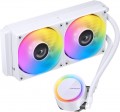Min. RPM
The lowest speed at which the cooling fan is capable of operating. Specified only for models with speed control (see below).
The lower the minimum speed (with the same maximum) — the wider the speed control range and the more you can slow down the fan when high performance is not needed (such a slowdown allows you to reduce energy consumption and noise level). On the other hand, an extensive range affects the cost accordingly.
Max. air flow
The maximum airflow that a cooling fan can create; measured in CFM — cubic feet per minute.
The higher the CFM number, the more efficient the fan. On the other hand, high performance requires either a large diameter (which affects the size and cost) or high speed (which increases the noise and vibration levels). Therefore, when choosing, it makes sense not to chase the maximum air flow, but to use special formulas that allow you to calculate the required number of CFM depending on the type and power of the cooled component and other parameters. Such formulas can be found in special sources. As for specific numbers, in the most modest systems, the performance
does not exceed 30 CFM, and in the most powerful systems it can be up to 80 CFM and even
more.
It is also worth considering that the actual value of the air flow at the highest speed is usually lower than the claimed maximum; see Static Pressure for details.
Noise level
The standard noise level generated by the cooling system during operation. Usually, this paragraph indicates the maximum noise during normal operation, without overloads and other "extreme".
Note that the noise level is indicated in decibels, and this is a non-linear value. So it is easiest to evaluate the actual loudness using comparative tables. Here is a table for values found in modern cooling systems:
20 dB — barely audible sound (quiet whisper of a person at a distance of about 1 m, sound background in an open field outside the city in calm weather);
25 dB — very quiet (normal whisper at a distance of 1 m);
30 dB — quiet (wall clock). It is this noise that, according to sanitary standards, is the maximum allowable for constant sound sources at night (from 23.00 to 07.00). This means that if the computer is planned to sit at night, it is desirable that the volume of the cooling system does not exceed this value.
35 dB — conversation in an undertone, sound background in a quiet library;
40 dB — conversation, relatively quiet, but already in full voice. The maximum permissible noise level for residential premises in the daytime, from 7.00 to 23.00, according to sanitary standards. However, even the noisiest cooling systems usually do not reach this indicator, the maximum for such equipment is about 38 – 39 dB.
Pump size
The dimensions of the pump that the water cooling system is equipped with.
Most often, this parameter is indicated for all three dimensions: length, width and thickness (height). These dimensions determine two points: the space required to install the pump, and the diameter of its working part. With the first, everything is quite obvious; we only note that in some systems the pump simultaneously plays the role of a water block and is installed directly on the cooled component of the system, and it is there that there should be enough space. The diameter approximately corresponds to the length and width of the pump (or the smaller of these dimensions if they are not the same — for example, 55 mm in the model 60x55x43 mm). Some operating features depend on this parameter. So, the large diameter of the pump allows you to achieve the required performance at a relatively low rotation speed; the latter, in turn, reduces the noise level and increases the overall reliability of the structure. On the other hand, a large pump costs more and takes up more space.
Pump rotation speed
The speed at which the working part of the pump rotates, which is nominally provided in the water cooling system.
High speed, on the one hand, has a positive effect on performance, on the other hand, it increases the noise level and reduces the time between failures. Therefore, with the same performance, relatively “slow” pumps are considered more advanced, in which the necessary pumping volumes are achieved due to the large diameter of the working part, and not due to speed.
Manufacturer's warranty
Manufacturer's warranty provided for this model.
In fact, this is the minimum service life promised by the manufacturer, provided that the operating rules are followed. Most often, the actual service life of the device turns out to be significantly longer than the guaranteed one. Among the modest indicators there are
models with a 1-year or
2-year warranty, more serious models already have
a 3-year warranty, and the most confident manufacturers give
a 5-year or even
6-year warranty.
Dimensions
General dimensions of the cooling system. For water systems (see "Type"), this paragraph indicates the size of the external radiator (the dimensions of the water block in such devices are small, and there is no need to specify them in particular).
In general, this is a fairly obvious parameter. We only note that for case fans (see ibid.), the thickness is of particular importance — it directly depends on how much space the device will take up inside the system unit. At the same time, it is customary to refer to
fans with a thin case for models in which this size does not exceed 20 mm.

